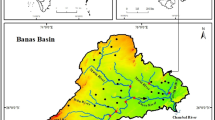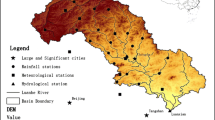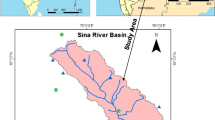Abstract
Drought is a serious natural hazard caused by a lack of precipitation in relation to what is expected or normal, which, if prolonged over a season or longer time, is insufficient to fulfil human activity demands. It is a seasonal, localised natural occurrence of the climate. Droughts are thus primarily brought on by precipitation deficits brought on by regional and temporal natural climate variability. Droughts cannot be stopped, but their effects on people and plants can be lessened by being well-prepared for their likely occurrence. India experienced a 22% total rainfall deficiency in 2009, which reduced food grain production by 16 million tonnes. The drought that affected a considerable portion of the nation in 2014, 2015, and 2016 caused significant problems for the affected populace since it devastated important agricultural regions of the nation. The Arjunanadhi sub-basin typically experiences heat and drought every five years, according to the project report for Irrigated Agriculture Modernization and Water-Bodies Restoration and Management (IAMWARM). The purpose of this research is to pinpoint the variable that causes drought in the Vaippar river's sub-basins of Arjunanadhi and Koushiganadhi. The Standardized Precipitation Index (SPI) for meteorological drought, the Water Requirement Satisfaction Index (WRSI) tool for agricultural drought, and the Herbst method for hydrological drought are used to establish a link between crop production and crop area. Meteorological, hydrological, and agricultural drought are assessed using a variety of methods, including GIS, Multivariate Analysis, and the use of different indicators. Based on the return period of drought calculated using SPI for the Arjunanadhi and Koushiganadhi sub-basins, the overall drought happens once every three to four years. When the land is used for paddy and sugarcane, the Arjunanadhi and Koushiganadhi sub-basins' Water Requirement Satisfaction Index is extremely susceptible to drought. The stream flow statistics from the reservoirs at Anaikuttam and Kullursandai indicate that the Arjunanadhi and Koushiganadhi were impacted by severe and extreme drought, according to the hydrological drought evaluation's negative indicators. As per multivariate analysis, rainfall is the factor most likely to influence the probability of drought since the independent variable crop production has a better correlation with the SPI indices and crop area.


















Similar content being viewed by others
Data availability
All data generated or analysed during this study are included in this published article.
References
Bazrafshan J, Hejabi S, Rahimi J (2014) Drought monitoring using the multivariate standardized precipitation index (MSPI). Water Resour Manage 28:1045–1060
Dracup JA, Lee KS, Paulson EG Jr (1980) On the definition of droughts. Water Resour Res 16(2):297–302
Gedif B, Hadish L, Addisu L, Suryabhagavan KV (2014) Drought risk assessment using remote sensing and GIS: the case of southern zone, Tigray Region, Ethiopia. J Nat Sci Res 4(23):87–94
Herbst PH, Bredenkamp D, Barker HMG (1966) A technique for the evaluation of drought from rainfall data. J Hydrol 4:264–272
Kannan PG, Govindasamy R (2022a) Drought severity assessments in the Arjunanadhi and Kousiganadhi subbasins of Tamil Nadu, India: a meteorological perspective. Theoret Appl Climatol 149(3–4):1079–1091
Kannan PG, Govindasamy R (2022b) Mitigation and management of agricultural drought assessment in Arjunanadhi and Kousiganadhi Sub-Basins in Tamil Nadu, India. Arab J Geosci 15(9):809
Li Q, Zeng M, Wang H, Li P, Wang K, Yu M (2015) Drought assessment using a multivariate drought index in the Huaihe River basin of Eastern China. Proc Int Assoc Hydrol Sci 369(369):61–67
Monacelli G, Galluccio MC, Abbafati M (2005a) Drought assessment and forecasting. Drought within the Context of the Region VI 26:88
Monacelli G, Galluccio MC, Abbafati M (2005b) Drought within the context of the region VI. Italian Agency for Environmental Protection and Technical Services (APAT), Hydrology and Inland Waters Service
Niemeyer S (2008) New drought indices. European Commission, DG Joint Research Centre. Institute for Environment and Sustainability, TP:261.
Palmer WC (1965) Meteorological drought (Vol. 30). US Department of Commerce, Weather Bureau
Perez GJ, Macapagal M, Olivares R, Macapagal EM, Comiso JC (2016) Forecasting and monitoring agricultural drought in the Philippines. Int Arch Photogramm Remote Sens Spatial Inf Sci 41:1263–1269
Santos PM, Pezzopane JRM, Mendonça FC, Bettiol GM, Evangelista BA, Silva FAMD (2012) Climatic risk zoning for corn and palisade grass (Brachiaria brizantha cv: Marandu) cultivated in integrated crop-livestock systems in São Paulo state, Brazil. Revista Brasileira De Zootecnia 41:36–40
Sun L, Mitchell SW, Davidson A (2012) Multiple drought indices for agricultural drought risk assessment on the Canadian prairies. Int J Climatol 32(11):1628–1639
Swain S, Mishra SK, Pandey A (2021) A detailed assessment of meteorological drought characteristics using simplified rainfall index over Narmada River Basin, India. Environ Earth Sci 80:221
Swain S, Mishra SK, Pandey A (2022a) Assessing spatiotemporal variation in drought characteristics and their dependence on timescales over Vidarbha Region, India. Geocarto Int 37:17971–17993
Swain S, Mishra SK, Pandey A, Dayal D (2022b) Assessment of drought trends and variabilities over the agriculture-dominated Marathwada Region, India. Environ Monitor Assess 194(12):883
Swain S, Mishra SK, Pandey A, Kalura P (2022c) Inclusion of groundwater and socio-economic factors for assessing comprehensive drought vulnerability over Narmada River Basin, India: a geospatial approach. Appl Water Sci 12(2):14
Swain S, Mishra SK, Pandey A, Srivastava PK, Nandi S (2023) Characterization and assessment of hydrological droughts using GloFAS streamflow data for the Narmada River Basin. India Environ Sci Pollut Res. https://doi.org/10.1007/s11356-023-27036-8
Thornthwaite CW (1948) An approach toward a rational classification of climate. Geogr Rev 38(1):55–94
WMO (1975) Drought and agriculture. Report of the CAgM Working Group on the Assessment of Drought prepared by C.E. Hounam (Chairman), J.J. Burgos, M.S. Kalik, W.C. Palmer and J. Rodda. Technical Note No. 138, WMO No. 392, World Meteorological Organization, Geneva.
Yevjevich VM (1967) Objective approach to definitions and investigations of continental hydrologic droughts, An (Doctoral dissertation, Colorado State University. Libraries)
Funding
Not applicable.
Author information
Authors and Affiliations
Contributions
Conceptualization, methodology, formal analysis and investigation were contributed by PRGK. Writing—original draft preparation, was contributed by VARP. Writing—review and editing, was contributed by SK. Supervision was contributed by RG.
Corresponding author
Ethics declarations
Competing interests
The authors declare no competing interests.
Ethical approval
Not applicable.
Consent to participate
Not applicable.
Consent to publish
Applicable.
Rights and permissions
Springer Nature or its licensor (e.g. a society or other partner) holds exclusive rights to this article under a publishing agreement with the author(s) or other rightsholder(s); author self-archiving of the accepted manuscript version of this article is solely governed by the terms of such publishing agreement and applicable law.
About this article
Cite this article
Kannan, P.R.G., Panchabikesan, V.A.R., Kamaraj, S. et al. Drought assessment using multivariate indices in the sub-basins of the Vaippar River Basin, Tamil Nadu, India. Paddy Water Environ 22, 61–83 (2024). https://doi.org/10.1007/s10333-023-00953-7
Received:
Revised:
Accepted:
Published:
Issue Date:
DOI: https://doi.org/10.1007/s10333-023-00953-7




